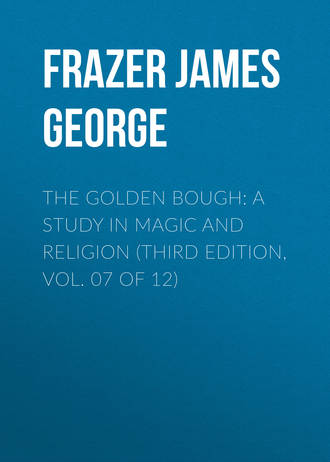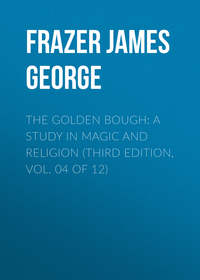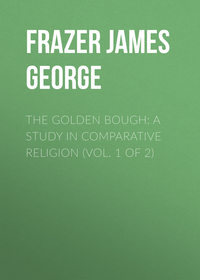 полная версия
полная версияThe Golden Bough: A Study in Magic and Religion (Third Edition, Vol. 07 of 12)
Agricultural work done by women among the Indian tribes of South America.
A similar division of labour between men and women prevails among many primitive agricultural tribes of Indians in South America. “In the interior of the villages,” says an eminent authority on aboriginal South America, “the man often absents himself to hunt or to go into the heart of the forest in search of the honey of the wild bees, and he always goes alone. He fells the trees in the places where he wishes to make a field for cultivation, he fashions his weapons, he digs out his canoe, while the woman rears the children, makes the garments, busies herself with the interior, cultivates the field, gathers the fruits, collects the roots, and prepares the food. Such is, generally at least, the respective condition of the two sexes among almost all the Americans. The Peruvians alone had already, in their semi-civilised state, partially modified these customs; for among them the man shared the toils of the other sex or took on himself the most laborious tasks.”383 Thus, to take examples, among the Caribs of the West Indies the men used to fell the trees and leave the fallen trunks to cumber the ground, burning off only the smaller boughs. Then the women came and planted manioc, potatoes, yams, and bananas wherever they found room among the tree-trunks. In digging the ground to receive the seed or the shoots they did not use hoes but simply pointed sticks. The men, we are told, would rather have died of hunger than undertake such agricultural labours.384 Again, the staple vegetable food of the Indians of British Guiana is cassava bread, made from the roots of the manioc or cassava plant, which the Indians cultivate in clearings of the forest. The men fell the trees, cut down the undergrowth, and in dry weather set fire to the fallen lumber, thus creating open patches in the forest which are covered with white ashes. When the rains set in, the women repair to these clearings, heavily laden with baskets full of cassava sticks to be used as cuttings. These they insert at irregular intervals in the soil, and so the field is formed. While the cassava is growing, the women do just as much weeding as is necessary to prevent the cultivated plants from being choked by the rank growth of the tropical vegetation, and in doing so they plant bananas, pumpkin seeds, yams, sweet potatoes, sugar-cane, red and yellow peppers, and so forth, wherever there is room for them. At last in the ninth or tenth month, when the seeds appearing on the straggling branches of the cassava plants announce that the roots are ripe, the women cut down the plants and dig up the roots, not all at once, but as they are required. These roots they afterwards peel, scrape, and bake into cassava bread.385
Cultivation of manioc by women among the Indian tribes of tropical South America.
In like manner the cassava or manioc plant is cultivated generally among all the Indian tribes of tropical South America, wherever the plant will grow; and the cultivation of it is altogether in the hands of the women, who insert the sticks in the ground after the fashion already described.386 For example, among the tribes of the Uaupes River, in the upper valley of the Amazon, who are an agricultural people with settled abodes, “the men cut down the trees and brushwood, which, after they have lain some months to dry, are burnt; and the mandiocca is then planted by the women, together with little patches of cane, sweet potatoes, and various fruits. The women also dig up the mandiocca, and prepare from it the bread which is their main subsistence… The bread is made fresh every day, as when it gets cold and dry it is far less palatable. The women thus have plenty to do, for every other day at least they have to go to the field, often a mile or two distant, to fetch the root, and every day to grate, prepare, and bake the bread; as it forms by far the greater part of their food, and they often pass days without eating anything else, especially when the men are engaged in clearing the forest.”387 Among the Tupinambas, a tribe of Brazilian Indians, the wives “had something more than their due share of labour, but they were not treated with brutality, and their condition was on the whole happy. They set and dug the mandioc; they sowed and gathered the maize. An odd superstition prevailed, that if a sort of earth-almond, which the Portugueze call amendoens, was planted by the men, it would not grow.”388 Similar accounts appear to apply to the Brazilian Indians in general: the men occupy themselves with hunting, war, and the manufacture of their weapons, while the women plant and reap the crops, and search for fruits in the forest;389 above all they cultivate the manioc, scraping the soil clear of weeds with pointed sticks and inserting the shoots in the earth.390 Similarly among the Indians of Peru, who cultivate maize in clearings of the forest, the cultivation of the fields is left to the women, while the men hunt with bows and arrows and blowguns in the woods, often remaining away from home for weeks or even months together.391
Agricultural work done by women among savage tribes in India, New Guinea, and New Britain.
A similar distribution of labour between the sexes prevails among some savage tribes in other parts of the world. Thus among the Lhoosai of south-eastern India the men employ themselves chiefly in hunting or in making forays on their weaker neighbours, but they clear the ground and help to carry home the harvest. However, the main burden of the bodily labour by which life is supported falls on the women; they fetch water, hew wood, cultivate the ground, and help to reap the crops.392 Among the Miris of Assam almost the whole of the field work is done by the women. They cultivate a patch of ground for two successive years, then suffer it to lie fallow for four or five. But they are deterred by superstitious fear from breaking new ground so long as the fallow suffices for their needs; they dread to offend the spirits of the woods by needlessly felling the trees. They raise crops of rice, maize, millet, yams, and sweet potatoes. But they seldom possess any implement adapted solely for tillage; they have never taken to the plough nor even to a hoe. They use their long straight swords to clear, cut, and dig with.393 Among the Korwas, a savage hill tribe of Bengal, the men hunt with bows and arrows, while the women till the fields, dig for wild roots, or cull wild vegetables. Their principal crop is pulse (Cajanus Indicus).394 Among the Papuans of Ayambori, near Doreh in Dutch New Guinea, it is the men who lay out the fields by felling and burning the trees and brushwood in the forest, and it is they who enclose the fields with fences, but it is the women who sow and reap them and carry home the produce in sacks on their backs. They cultivate rice, millet, and bananas.395 So among the natives of Kaimani Bay in Dutch New Guinea the men occupy themselves only with fishing and hunting, while all the field work falls on the women.396 In the Gazelle Peninsula of New Britain, when the natives have decided to convert a piece of grass-land into a plantation, the men cut down the long grass, burn it, dig up the soil with sharp-pointed sticks, and enclose the land with a fence of saplings. Then the women plant the banana shoots, weed the ground, and in the intervals between the bananas insert slips of yams, sweet potatoes, sugar-cane, or ginger. When the produce is ripe, they carry it to the village. Thus the bulk of the labour of cultivation devolves on the women.397
Division of agricultural work between men and women in the Indian Archipelago.
Among some peoples of the Indian Archipelago, after the land has been cleared for cultivation by the men, the work of planting and sowing is divided between men and women, the men digging holes in the ground with pointed sticks, and the women following them, putting the seeds or shoots into the holes, and then huddling the earth over them; for savages seldom sow broadcast, they laboriously dig holes and insert the seed in them. This division of agricultural labour between the sexes is adopted by various tribes of Celebes, Ceram, Borneo, Nias, and New Guinea.398 Sometimes the custom of entrusting the sowing of the seed to women appears to be influenced by superstitious as well as economic considerations. Thus among the Indians of the Orinoco, who with an infinitude of pains cleared the jungle for cultivation by cutting down the forest trees with their stone axes, burning the fallen lumber, and breaking up the ground with wooden instruments hardened in the fire, the task of sowing the maize and planting the roots was performed by the women alone; and when the Spanish missionaries expostulated with the men for not helping their wives in this toilsome duty, they received for answer that as women knew how to conceive seed and bear children, so the seeds and roots planted by them bore fruit far more abundantly than if they had been planted by male hands.399
Among savages who have not learned to till the ground the task of collecting the vegetable food in the form of wild seeds and roots generally devolves on women. Examples furnished by the Californian Indians.
Even among savages who have not yet learned to cultivate any plants the task of collecting the edible seeds and digging up the edible roots of wild plants appears to devolve mainly on women, while the men contribute their share to the common food supply by hunting and fishing, for which their superior strength, agility, and courage especially qualify them. For example, among the Indians of California, who were entirely ignorant of agriculture, the general division of labour between the sexes in the search for food was that the men killed the game and caught the salmon, while the women dug the roots and brought in most of the vegetable food, though the men helped them to gather acorns, nuts, and berries.400 Among the Indians of San Juan Capistrano in California, while the men passed their time in fowling, fishing, dancing, and lounging, “the women were obliged to gather seeds in the fields, prepare them for cooking, and to perform all the meanest offices, as well as the most laborious. It was painful in the extreme, to behold them, with their infants hanging upon their shoulders, groping about in search of herbs or seeds, and exposed as they frequently were to the inclemency of the weather.”401 Yet these rude savages possessed a calendar containing directions as to the seasons for collecting the different seeds and produce of the earth. The calendar consisted of lunar months corrected by observation of the solstices, “for at the conclusion of the moon in December, that is, at the conjunction, they calculated the return of the sun from the tropic of Capricorn; and another year commenced, the Indian saying ‘the sun has arrived at his home.’ … They observed with greater attention and celebrated with more pomp, the sun's arrival at the tropic of Capricorn than they did his reaching the tropic of Cancer, for the reason, that, as they were situated ten degrees from the latter, they were pleased at the sun's approach towards them; for it returned to ripen their fruits and seeds, to give warmth to the atmosphere, and enliven again the fields with beauty and increase.” However, the knowledge of the calendar was limited to the puplem or general council of the tribe, who sent criers to make proclamation when the time had come to go forth and gather the seeds and other produce of the earth. In their calculations they were assisted by a pul or astrologer, who observed the aspect of the moon.402 When we consider that these rude Californian savages, destitute alike of agriculture and of the other arts of civilised life, yet succeeded in forming for themselves a calendar based on observation both of the moon and of the sun, we need not hesitate to ascribe to the immeasurably more advanced Greeks at the dawn of history the knowledge of a somewhat more elaborate calendar founded on a cycle of eight solar years.403
Among the aborigines of Australia the women provided the vegetable food, while the men hunted.
Among the equally rude aborigines of Australia, to whom agriculture in every form was totally unknown, the division of labour between the sexes in regard to the collection of food appears to have been similar. While the men hunted game, the labour of gathering and preparing the vegetable food fell chiefly to the women. Thus with regard to the Encounter Bay tribe of South Australia we are told that while the men busied themselves, according to the season, either with fishing or with hunting emus, opossums, kangaroos, and so forth, the women and children searched for roots and plants.404 Again, among the natives of Western Australia “it is generally considered the province of women to dig roots, and for this purpose they carry a long, pointed stick, which is held in the right hand, and driven firmly into the ground, where it is shaken, so as to loosen the earth, which is scooped up and thrown out with the fingers of the left hand, and in this manner they dig with great rapidity. But the labour, in proportion to the amount obtained, is great. To get a yam about half an inch in circumference and a foot in length, they have to dig a hole above a foot square and two feet in depth; a considerable portion of the time of the women and children is, therefore, passed in this employment. If the men are absent upon any expedition, the females are left in charge of one who is old or sick; and in traversing the bush you often stumble on a large party of them, scattered about in the forest, digging roots and collecting the different species of fungus.”405 In fertile districts, where the yams which the aborigines use as food grow abundantly, the ground may sometimes be seen riddled with holes made by the women in their search for these edible roots. Thus to quote Sir George Grey: “We now crossed the dry bed of a stream, and from that emerged upon a tract of light fertile soil, quite overrun with warran [yam] plants, the root of which is a favourite article of food with the natives. This was the first time we had yet seen this plant on our journey, and now for three and a half consecutive miles we traversed a fertile piece of land, literally perforated with the holes the natives had made to dig this root; indeed we could with difficulty walk across it on that account, whilst this tract extended east and west as far as we could see.”406 Again, in the valley of the Lower Murray River a kind of yam (Microseris Forsteri) grew plentifully and was easily found in the spring and early summer, when the roots were dug up out of the earth by the women and children. The root is small and of a sweetish taste and grows throughout the greater part of Australia outside the tropics; on the alpine pastures of the high Australian mountains it attains to a much larger size and furnishes a not unpalatable food.407 But the women gather edible herbs and seeds as well as roots; and at evening they may be seen trooping in to the camp, each with a great bundle of sow-thistles, dandelions, or trefoil on her head,408 or carrying wooden vessels filled with seeds, which they afterwards grind up between stones and knead into a paste with water or bake into cakes.409 Among the aborigines of central Victoria, while the men hunted, the women dug up edible roots and gathered succulent vegetables, such as the young tops of the munya, the sow-thistle, and several kinds of fig-marigold. The implement which they used to dig up roots with was a pole seven or eight feet long, hardened in the fire and pointed at the end, which also served them as a weapon both of defence and of offence.410 Among the tribes of Central Australia the principal vegetable food is the seed of a species of Claytonia, called by white men munyeru, which the women gather in large quantities and winnow by pouring the little black seeds from one vessel to another so as to let the wind blow the loose husks away.411
The digging of the earth for wild fruits may have led to the origin of agriculture.
In these customs observed by savages who are totally ignorant of agriculture we may perhaps detect some of the steps by which mankind have advanced from the enjoyment of the wild fruits of the earth to the systematic cultivation of plants. For an effect of digging up the earth in the search for roots has probably been in many cases to enrich and fertilise the soil and so to increase the crop of roots or herbs; and such an increase would naturally attract the natives in larger numbers and enable them to subsist for longer periods on the spot without being compelled by the speedy exhaustion of the crop to shift their quarters and wander away in search of fresh supplies. Moreover, the winnowing of the seeds on ground which had thus been turned up by the digging-sticks of the women would naturally contribute to the same result. For though savages at the level of the Californian Indians and the aborigines of Australia have no idea of using seeds for any purpose but that of immediate consumption, and it has never occurred to them to incur a temporary loss for the sake of a future gain by sowing them in the ground, yet it is almost certain that in the process of winnowing the seeds as a preparation for eating them many of the grains must have escaped and, being wafted by the wind, have fallen on the upturned soil and borne fruit. Thus by the operations of turning up the ground and winnowing the seed, though neither operation aimed at anything beyond satisfying the immediate pangs of hunger, savage man or rather savage woman was unconsciously preparing for the whole community a future and more abundant store of food, which would enable them to multiply and to abandon the old migratory and wasteful manner of life for a more settled and economic mode of existence. So curiously sometimes does man, aiming his shafts at a near but petty mark, hit a greater and more distant target.
The discovery of agriculture due mainly to women.
On the whole, then, it appears highly probable that as a consequence of a certain natural division of labour between the sexes women have contributed more than men towards the greatest advance in economic history, namely, the transition from a nomadic to a settled life, from a natural to an artificial basis of subsistence.
Women as agricultural labourers among the Aryans of Europe. The Greek conception of the Corn Goddess probably originated in a simple personification of the corn.
Among the Aryan peoples of Europe the old practice of hoeing the ground as a preparation for sowing appears to have been generally replaced at a very remote period by the far more effective process of ploughing;412 and as the labour of ploughing practically necessitates the employment of masculine strength, it is hardly to be expected that in Europe many traces should remain of the important part formerly played by women in primitive agriculture. However, we are told that among the Iberians of Spain and the Athamanes of Epirus the women tilled the ground,413 and that among the ancient Germans the care of the fields was left to the women and old men.414 But these indications of an age when the cultivation of the ground was committed mainly to feminine hands are few and slight; and if the Greek conception of Demeter as a goddess of corn and agriculture really dates from such an age and was directly suggested by such a division of labour between the sexes, it seems clear that its origin must be sought at a period far back in the history of the Aryan race, perhaps long before the segregation of the Greeks from the common stock and their formation into a separate people. It may be so, but to me I confess that this derivation of the conception appears somewhat far-fetched and improbable; and I prefer to suppose that the idea of the corn as feminine was suggested to the Greek mind, not by the position of women in remote prehistoric ages, but by a direct observation of nature, the teeming head of corn appearing to the primitive fancy to resemble the teeming womb of a woman, and the ripe ear on the stalk being likened to a child borne in the arms or on the back of its mother. At least we know that similar sights suggest similar ideas to some of the agricultural negroes of West Africa. Thus the Hos of Togoland, who plant maize in February and reap it in July, say that the maize is an image of a mother; when the cobs are forming, the mother is binding the infant on her back, but in July she sinks her head and dies and the child is taken away from her, to be afterwards multiplied at the next sowing.415 When the rude aborigines of Western Australia observe that a seed-bearing plant has flowered, they call it the Mother of So-and-so, naming the particular kind of plant, and they will not allow it to be dug up.416 Apparently they think that respect and regard are due to the plant as to a mother and her child. Such simple and natural comparisons, which may occur to men in any age and country, suffice to explain the Greek personification of the corn as mother and daughter, and we need not cast about for more recondite theories. Be that as it may, the conception of the corn as a woman and a mother was certainly not peculiar to the ancient Greeks, but has been shared by them with many other races, as will appear abundantly from the instances which I shall cite in the following chapter.
Chapter V. The Corn-Mother and the Corn-Maiden in Northern Europe
Suggested derivation of the name Demeter.
It has been argued by W. Mannhardt that the first part of Demeter's name is derived from an alleged Cretan word deai, “barley,” and that accordingly Demeter means neither more nor less than “Barley-mother” or “Corn-mother”;417 for the root of the word seems to have been applied to different kinds of grain by different branches of the Aryans.418 As Crete appears to have been one of the most ancient seats of the worship of Demeter,419 it would not be surprising if her name were of Cretan origin. But the etymology is open to serious objections,420 and it is safer therefore to lay no stress on it. Be that as it may, we have found independent reasons for identifying Demeter as the Corn-mother, and of the two species of corn associated with her in Greek religion, namely barley and wheat, the barley has perhaps the better claim to be her original element; for not only would it seem to have been the staple food of the Greeks in the Homeric age, but there are grounds for believing that it is one of the oldest, if not the very oldest, cereal cultivated by the Aryan race. Certainly the use of barley in the religious ritual of the ancient Hindoos as well as of the ancient Greeks furnishes a strong argument in favour of the great antiquity of its cultivation, which is known to have been practised by the lake-dwellers of the Stone Age in Europe.421
Analogies to the Corn-mother or Barley-mother of ancient Greece have been collected in great abundance by W. Mannhardt from the folk-lore of modern Europe. The following may serve as specimens.
The Corn-mother among the Germans and the Slavs.
In Germany the corn is very commonly personified under the name of the Corn-mother. Thus in spring, when the corn waves in the wind, the peasants say, “There comes the Corn-mother,” or “The Corn-mother is running over the field,” or “The Corn-mother is going through the corn.”422 When children wish to go into the fields to pull the blue corn-flowers or the red poppies, they are told not to do so, because the Corn-mother is sitting in the corn and will catch them.423 Or again she is called, according to the crop, the Rye-mother or the Pea-mother, and children are warned against straying in the rye or among the peas by threats of the Rye-mother or the Pea-mother. In Norway also the Pea-mother is said to sit among the peas.424 Similar expressions are current among the Slavs. The Poles and Czechs warn children against the Corn-mother who sits in the corn. Or they call her the old Corn-woman, and say that she sits in the corn and strangles the children who tread it down.425 The Lithuanians say, “The Old Rye-woman sits in the corn.”426 Again the Corn-mother is believed to make the crop grow. Thus in the neighbourhood of Magdeburg it is sometimes said, “It will be a good year for flax; the Flax-mother has been seen.” At Dinkelsbühl, in Bavaria, down to the latter part of the nineteenth century, people believed that when the crops on a particular farm compared unfavourably with those of the neighbourhood, the reason was that the Corn-mother had punished the farmer for his sins.427 In a village of Styria it is said that the Corn-mother, in the shape of a female puppet made out of the last sheaf of corn and dressed in white, may be seen at midnight in the corn-fields, which she fertilises by passing through them; but if she is angry with a farmer, she withers up all his corn.428








